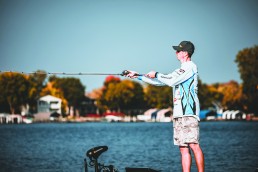The Versatility of Soft Plastic Swimbaits
SHARE THIS POST
If you’ve been looking for something to help you catch a really big bass, Glenn Walker recommends that you give swimbaits a shot. They can be a great option when fishing in tough situations.
When you say the word swimbait around bass fishermen, their thoughts often go to big baits that cost a lot of money, chiefly designed for targeting big bass. But, the soft plastic swimbait is also a great lure option to target big bass in a variety of fish-holding cover.
Soft plastic swimbaits have also evolved into versatile options for natural presentations in numerous situations.
One of the ways that soft plastic swimbaits, both solid and hollow-bodied, can be rigged is on a Texas-rig, so you can fish your bait through heavy cover, offering a very natural-looking presentation in the dense cover that bass live in.
Some areas where this presentation shines include shallow vegetation, such as eel grass flats and lily pad fields. You can fish this bait along the edge and let it just tick the vegetation or cast it into the grass and bring it through the cover; this will look like a baitfish or bluegill fleeing a predator.
The two other areas of shallow-water cover where Texas-rigged swimbaits excel are laydowns and boat docks. Bass that inhabit these areas see countless jigs, spinnerbaits and even shallow-running crankbaits. So, if you can present something different to those fish, you are likely to have some great days on the water. Boat docks host a plethora of baitfish and bluegills; a swimbait mimicking that forage will tempt bass to come out from underneath the dock to hit your presentation.
Two hook options for this presentation include a standard extra-wide gap hook with a small tungsten weight in front of it, and a specialty swimbait hook with a corkscrew up at the hook eye and a weight on the shaft or bend of the hook.
My two choices would be a Lazer TroKar Magworm (TK120) 4/0 or 5/0 hook, depending on the size of the swimbait, with a 1/16- or 1/8-ounce tungsten weight pegged in front of the hook. I use this set up when fishing in and around vegetation, as it will come through the cover with ease. When fishing around boat docks or laydowns, I opt to go with a swimbait hook like the TroKar Magnum Weight Swimbait (TK170) hook. If you need to add some additional action to your swimbait setup, a hook with a small blade attached to the keel of the hook adds flash and additional vibration to the swimbait package, like the TroKar Swim Blade (TK178).
Are you enjoying this post?
You can be among the first to get the latest info on where to go, what to use and how to use it!
Regardless of which rigging option I go with, I use a long 7-foot, 6-inch Witch Doctor Tackle Voodoo II medium-heavy power, fast action rod, as I can make long casts, feel exactly what my bait is doing, and have the power to get bass out of the heavy cover. For line, I use either 15- or 17-pound-test Seaguar Inviz X Fluorocarbon line as it is very abrasion resistant and I can make long casts with it.
Another reason that the swimbait is so versatile is that it makes a great trailer for several lures— a swim jig, vibrating jig or spinnerbait. It is something different from a standard grub, thus giving your bait a bigger profile and different appearance than other anglers are presenting to the bass.
Selecting colors for swimbaits as a jig trailer can go in two different directions. The first is to match the hatch as they say, meaning if you are fishing in clear water and the bass want a natural presentation, then go with a swimbait that looks like what the bass are eating. If they are eating shad, go with a shad-colored swimbait, and if they are eating bluegills, go with bait that has more of a brown, green and blue color pattern to it.
The other color selection possibility is when fishing in stained water: Go with a swimbait that stands out and brings attention to your lure. When fishing a white swim jig or spinnerbait in spring on a stained river, use a chartreuse color swimbait; this will really make your bait pop and catch the bass’s attention.
My go-to jig head for fishing a soft plastic swimbait is the All-Terrain Tackle Smallie Smasher Swimbait Head. What sets this head apart from others, and why I choose it, is that it uses an extra-long hook. This puts the hook point towards the back for the swimbait, so your hookup ratio will go up, especially when smallmouths are short striking the bait. Depending on the depth of water I am fishing and the size of the swimbait I’m using, I can choose from either a 1/4- or 3/8-ounce head, in two different hook sizes, to match the head to the length of the swimbait you are using.
Retrieving a swimbait rigged on a jighead is straight forward—cast out and reel in. But, you want to keep your retrieve at a steady pace and keep the swimbait from rolling, as this unnatural action will deter bass from striking.
Want to try a new fishing technique this season? You’ll find plenty of suggestions in the spring issues of MidWest Outdoors, available now at the newsstand or by subscribing on our website.
MWO
SHARE THIS POST
You may also like...
Nothing found.
Did you enjoy this post?
You can be among the first to get the latest info on where to go, what to use and how to use it!
Glenn Walker
Glenn Walker has been fishing Minnesota and Mississippi River tournaments for more than 15 years, spreading his passion and knowledge of the sport via articles and videos. For more information, check out glennwalkerfishing.com or on Facebook @GlennWalkerFishing.
